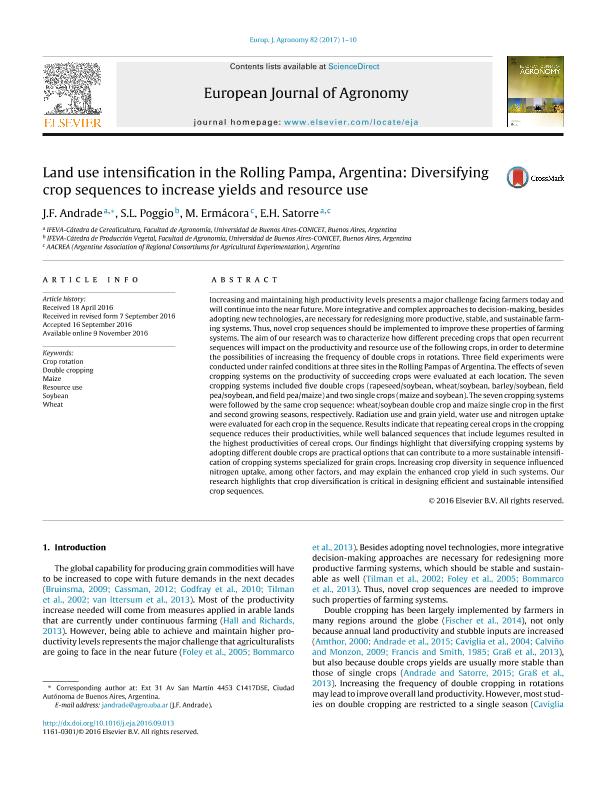Mostrar el registro sencillo del ítem
dc.contributor.author
Andrade, José Francisco

dc.contributor.author
Poggio, Santiago Luis

dc.contributor.author
Ermacora, Mario Roberto

dc.contributor.author
Satorre, Emilio Horacio

dc.date.available
2018-08-17T15:58:36Z
dc.date.issued
2016-11
dc.identifier.citation
Andrade, José Francisco; Poggio, Santiago Luis; Ermacora, Mario Roberto; Satorre, Emilio Horacio; Land use intensification in the Rolling Pampa, Argentina: Diversifyingcrop sequences to increase yields and resource use; Elsevier Science; European Journal of Agronomy; 82; Part A; 11-2016; 1-10
dc.identifier.issn
1161-0301
dc.identifier.uri
http://hdl.handle.net/11336/56139
dc.description.abstract
Increasing and maintaining high productivity levels presents a major challenge facing farmers today and will continue into the near future. More integrative and complex approaches to decision-making, besides adopting new technologies, are necessary for redesigning more productive, stable, and sustainable farming systems. Thus, novel crop sequences should be implemented to improve these properties of farming systems. The aim of our research was to characterize how different preceding crops that open recurrent sequences will impact on the productivity and resource use of the following crops, in order to determine the possibilities of increasing the frequency of double crops in rotations. Three field experiments were conducted under rainfed conditions at three sites in the Rolling Pampas of Argentina. The effects of seven cropping systems on the productivity of succeeding crops were evaluated at each location. The seven cropping systems included five double crops (rapeseed/soybean, wheat/soybean, barley/soybean, field pea/soybean, and field pea/maize) and two single crops (maize and soybean). The seven cropping systems were followed by the same crop sequence: wheat/soybean double crop and maize single crop in the first and second growing seasons, respectively. Radiation use and grain yield, water use and nitrogen uptake were evaluated for each crop in the sequence. Results indicate that repeating cereal crops in the cropping sequence reduces their productivities, while well balanced sequences that include legumes resulted in the highest productivities of cereal crops. Our findings highlight that diversifying cropping systems by adopting different double crops are practical options that can contribute to a more sustainable intensification of cropping systems specialized for grain crops. Increasing crop diversity in sequence influenced nitrogen uptake, among other factors, and may explain the enhanced crop yield in such systems. Our research highlights that crop diversification is critical in designing efficient and sustainable intensified crop sequences.
dc.format
application/pdf
dc.language.iso
eng
dc.publisher
Elsevier Science

dc.rights
info:eu-repo/semantics/openAccess
dc.rights.uri
https://creativecommons.org/licenses/by-nc-sa/2.5/ar/
dc.subject
CROP ROTATION
dc.subject
DOUBLE CROPPING
dc.subject
MAIZE
dc.subject
RESOURCE USE
dc.subject
SOYBEAN
dc.subject
WHEAT
dc.subject.classification
Agricultura

dc.subject.classification
Agricultura, Silvicultura y Pesca

dc.subject.classification
CIENCIAS AGRÍCOLAS

dc.title
Land use intensification in the Rolling Pampa, Argentina: Diversifyingcrop sequences to increase yields and resource use
dc.type
info:eu-repo/semantics/article
dc.type
info:ar-repo/semantics/artículo
dc.type
info:eu-repo/semantics/publishedVersion
dc.date.updated
2018-08-16T15:10:29Z
dc.journal.volume
82
dc.journal.number
Part A
dc.journal.pagination
1-10
dc.journal.pais
Países Bajos

dc.journal.ciudad
Amsterdam
dc.description.fil
Fil: Andrade, José Francisco. Consejo Nacional de Investigaciones Científicas y Técnicas. Oficina de Coordinación Administrativa Parque Centenario. Instituto de Investigaciones Fisiológicas y Ecológicas Vinculadas a la Agricultura. Universidad de Buenos Aires. Facultad de Agronomía; Argentina
dc.description.fil
Fil: Poggio, Santiago Luis. Consejo Nacional de Investigaciones Científicas y Técnicas. Oficina de Coordinación Administrativa Parque Centenario. Instituto de Investigaciones Fisiológicas y Ecológicas Vinculadas a la Agricultura. Universidad de Buenos Aires. Facultad de Agronomía; Argentina
dc.description.fil
Fil: Ermacora, Mario Roberto. Asociación Argentina de Consorcios Regionales para la Experimentación Agrícola; Argentina. Consejo Nacional de Investigaciones Científicas y Técnicas; Argentina
dc.description.fil
Fil: Satorre, Emilio Horacio. Consejo Nacional de Investigaciones Científicas y Técnicas. Oficina de Coordinación Administrativa Parque Centenario. Instituto de Investigaciones Fisiológicas y Ecológicas Vinculadas a la Agricultura. Universidad de Buenos Aires. Facultad de Agronomía; Argentina
dc.journal.title
European Journal of Agronomy

dc.relation.alternativeid
info:eu-repo/semantics/altIdentifier/url/https://www.sciencedirect.com/science/article/pii/S1161030116301770
dc.relation.alternativeid
info:eu-repo/semantics/altIdentifier/doi/http://dx.doi.org/10.1016/j.eja.2016.09.013
Archivos asociados
